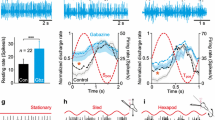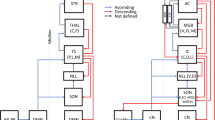Abstract
Vestibular influences on outflow from the spinal cord are largely mediated via spinal interneurons, although few studies have recorded interneuronal activity during labyrinthine stimulation. The present study determined the responses of upper thoracic interneurons of decerebrate cats to electrical stimulation of the vestibular nerve or natural stimulation of otolith organs and the anterior and posterior semicircular canals using rotations in vertical planes. A majority of thoracic interneurons (74/102) responded to vestibular nerve stimulation at median latencies of 6.5 ms (minimum of ~3 ms), suggesting that labyrinthine inputs were relayed to these neurons through trisynaptic and longer pathways. Thoracic interneuronal responses to vertical rotations were similar to those of graviceptors such as otolith organs, and a wide array of tilt directions preferentially activated different cells. Such responses were distinct from those of cells in the cervical and lumbar enlargements, which are mainly elicited by ear-down tilts and are synchronous with stimulus position when low rotational frequencies are delivered, but tend to be in phase with stimulus velocity when high frequencies are employed. The dynamic properties of thoracic interneuronal responses to tilts were instead similar to those of thoracic motoneurons and sympathetic preganglionic neurons. However, the preferred tilt directions of the interneurons were more heterogeneous than thoracic spinal outputs, showing that the outputs do not simply reflect an addition of local interneuronal activity.






Similar content being viewed by others
References
Barman SM, Gebber GL (1984) Spinal interneurons with sympathetic nerve-related activity. Am J Physiol 247:R761–R767
Brophy GM, Rossiter CD, Bolton PS, Yates BJ (1997) Vestibular influences on cat lumbar paravertebral muscles. Neurosci Lett 223:189–192
Estes MS, Blanks RH, Markham CH (1975) Physiologic characteristics of vestibular first-order canal neurons in the cat. I. Response plane determination and resting discharge characteristics. J Neurophysiol 38:1232–1249
Gacek RR (1969) The course and central termination of first order neurons supplying vestibular end organs in the cat. Acta-Otolaryngol Suppl 254:1–66
Gebber GL, McCall RB (1976) Identification and discharge patterns of spinal sympathetic interneurons. Am J Physiol 231:722–733
Institute for Laboratory Animal Research (1996) Guide for the care and use of laboratory animals. National Academy Press, Washington
Jian BJ, Shintani T, Emanuel BA, Yates BJ (2002) Convergence of limb, visceral, and vertical semicircular canal or otolith inputs onto vestibular nucleus neurons. Exp Brain Res 144:247–257
Kasper J, Schor RH, Wilson VJ (1988) Response of vestibular neurons to head rotations in vertical planes. I. Response to vestibular stimulation. J Neurophysiol 60:1753–1764
Kerman IA, McAllen RM, Yates BJ (2000) Patterning of sympathetic nerve activity in response to vestibular stimulation. Brain Res Bull 53:11–16
Kirkwood PA, Munson JB, Sears TA, Westgaard RH (1988) Respiratory interneurones in the thoracic spinal cord of the cat. J Physiol 395:161–192
Kirkwood PA, Schmid K, Sears TA (1993) Functional identities of thoracic respiratory interneurones in the cat. J Physiol 461:667–687
Kushiro K, Bai R, Kitajima N, Sugita-Kitajima A, Uchino Y (2008) Properties and axonal trajectories of posterior semicircular canal nerve-activated vestibulospinal neurons. Exp Brain Res 191:257–264
Money KE, Scott JW (1962) Functions of separate sensory receptors of nonauditory labyrinth of the cat. Am J Physiol 202:1211–1220
Nyberg-Hansen R (1964) Origin and termination of fibers from the vestibular nuclei descending in the medial longitudinal fasciculus. An experimental study with silver impregnation methods in the cat. J Comp Neurol 122:355–367
Nyberg-Hansen R, Mascitti TA (1964) Sites and mode of termination of fibers of the vestibulospinal tract in the cat. An experimental study with silver impregnation methods. J Comp Neurol 122:369–383
Petras JM (1967) Cortical, tectal and tegmental fiber connections in the spinal cord of the cat. Brain Res 6:275–324
Petrillo GA, Glass L (1984) A theory for phase locking of respiration in cats to a mechanical ventilator. Am J Physiol 246:R311–R320
Ray CA, Hume KM, Shortt TL (1997) Skin sympathetic outflow during head-down neck flexion in humans. Am J Physiol Regul Integr Comp Physiol 273:R1142–R1146
Roberts TDM (1978) Neurophysiology of postural mechanisms. Butterworths, London
Rossiter CD, Hayden NL, Stocker SD, Yates BJ (1996) Changes in outflow to respiratory pump muscles produced by natural vestibular stimulation. J Neurophysiol 76:3274–3284
Schmid K, Kirkwood PA, Munson JB, Shen E, Sears TA (1993) Contralateral projections of thoracic respiratory interneurones in the cat. J Physiol 461:647–665
Schor RH, Angelaki DE (1992) The algebra of neural response vectors. Ann N Y Acad Sci 656:190–204
Schor RH, Miller AD, Tomko DL (1984) Responses to head tilt in cat central vestibular neurons. I. Direction of maximum sensitivity. J Neurophysiol 51:136–146
Schor RH, Suzuki I, Timerick SJB, Wilson VJ (1986) Responses of interneurons in the cat cervical cord to vestibular tilt stimulation. J Neurophysiol 56:1147–1156
Schramm LP (2006) Spinal sympathetic interneurons: their identification and roles after spinal cord injury. Prog Brain Res 152:27–37
Suzuki I, Timerick SJB, Wilson VJ (1985) Body position with respect to head or body position in space is coded by lumbar interneurons. J Neurophysiol 54:123–133
Tang X, Neckel ND, Schramm LP (2003) Locations and morphologies of sympathetically correlated neurons in the T(10) spinal segment of the rat. Brain Res 976:185–193
Tang X, Neckel ND, Schramm LP (2004) Spinal interneurons infected by renal injection of pseudorabies virus in the rat. Brain Res 1004:1–7
Uchino Y, Kudo N, Tsuda K, Iwamura Y (1970) Vestibular inhibition of sympathetic nerve activities. Brain Res 22:195–206
Voustianiouk A, Kaufmann H, Diedrich A, Raphan T, Biaggioni I, Macdougall H, Ogorodnikov D, Cohen B (2006) Electrical activation of the human vestibulo-sympathetic reflex. Exp Brain Res 171:251–261
Wilson VJ, Melvill Jones G (1979) Mammalian vestibular physiology. Plenum Press, New York
Wilson VJ, Yoshida M, Schor RH (1970a) Monosynaptic excitation and inhibition of thoracic motoneurons by fibers in the medial longitudinal fasciculus. Brain Res 18:181–184
Wilson VJ, Yoshida M, Schor RH (1970b) Supraspinal monosynaptic excitation and inhibition of thoracic back motoneurons. Exp Brain Res 11:282–295
Wilson VJ, Gacek RR, Maeda M, Uchino Y (1977) Saccular and utricular input to cat neck motoneurons. J Neurophysiol 40:63–73
Wilson VJ, Schor RH, Suzuki I, Park BR (1986) Spatial organization of neck and vestibular reflexes acting on the forelimbs of the decerebrate cat. J Neurophysiol 55:514–526
Yates BJ, Miller AD (1994) Properties of sympathetic reflexes elicited by natural vestibular stimulation: implications for cardiovascular control. J Neurophysiol 71:2087–2092
Yates BJ, Jakus J, Miller AD (1993) Vestibular effects on respiratory outflow in the decerebrate cat. Brain Res 629:209–217
Zakir M, Ono S, Meng H, Uchino Y (2000) Saccular and utricular influences on sympathetic nerve activities in cats. Exp Brain Res 134:402–406
Zhang X, Zakir M, Meng H, Sato H, Uchino Y (2001) Convergence of the horizontal semicircular canal and otolith afferents on cat single vestibular neurons. Exp Brain Res 140:1–11
Acknowledgments
The authors thank Lucy Cotter, Allison Waggoner, and Michael Bonadio for technical assistance. Funding was provided by Grant R01-DC03732 from the National Institutes of Health (USA). Core support was provided by NIH grant P30-DC05205.
Author information
Authors and Affiliations
Corresponding author
Rights and permissions
About this article
Cite this article
Miller, D.M., Reighard, D.A., Mehta, A.S. et al. Responses of thoracic spinal interneurons to vestibular stimulation. Exp Brain Res 195, 89–100 (2009). https://doi.org/10.1007/s00221-009-1754-0
Received:
Accepted:
Published:
Issue Date:
DOI: https://doi.org/10.1007/s00221-009-1754-0




